How To Swing A Golf Club
While there are many different takes on how to swing a golf club, getting certain fundamentals right will give you a much better chance of playing consistently


Even at the highest level of the game the top professionals swing the golf club in very different ways. There is certainly more than one way of getting the job done - think Jim Furyk or Matthew Wolff, for example.
But if you’re new to the game or still in the early stages, getting the fundamentals as correct as possible will certainly help you to develop a more consistent golf swing. Many of the different-looking swings you see actually rely on compensatory movements at various stages to be able to deliver the club back to the ball squarely.
While good players may be able to time these movements consistently thanks to many hours of practice and repetition, for lesser golfing mortals, it’s a tougher challenge and one that invariably leads to inconsistency.
Here, we break down the fundamentals from grip to follow-through pooling advice offered by a number of our expert team of top coaches. The whole movement only takes a second, so getting the fundamentals right in each element of the swing will give you a better chance of the whole thing knitting together more effectively.
For example, setting up correctly will give you a better chance of taking the club away correctly. Taking the club away correctly will give you more chance of completing the backswing effectively and so on…
The Grip
While some golfers play well with stronger or weaker grips, a neutral grip is the ideal starting point.
A strong grip is one in which the upper hand sits on top of the grip too much and the lower hand too much underneath the grip, with things vice versa in a weak grip.
Subscribe to the Golf Monthly newsletter to stay up to date with all the latest tour news, equipment news, reviews, head-to-heads and buyer’s guides from our team of experienced experts.
In a neutral grip, the club’s grip should run along the base of the little finger, on through the other fingers until intersecting the middle part of the index finger.

This is how the grip should sit in your left or upper hand
For the perfect golf grip that keeps the clubface neutral, when you wrap your hand over, the V created by the thumb and index finger should point at your right shoulder.
In the game’s most common overlapping grip, the little finger of your right hand sits over your left forefinger and middle finger. The resulting V created by the thumb and forefinger of your right hand should point towards your right chest.
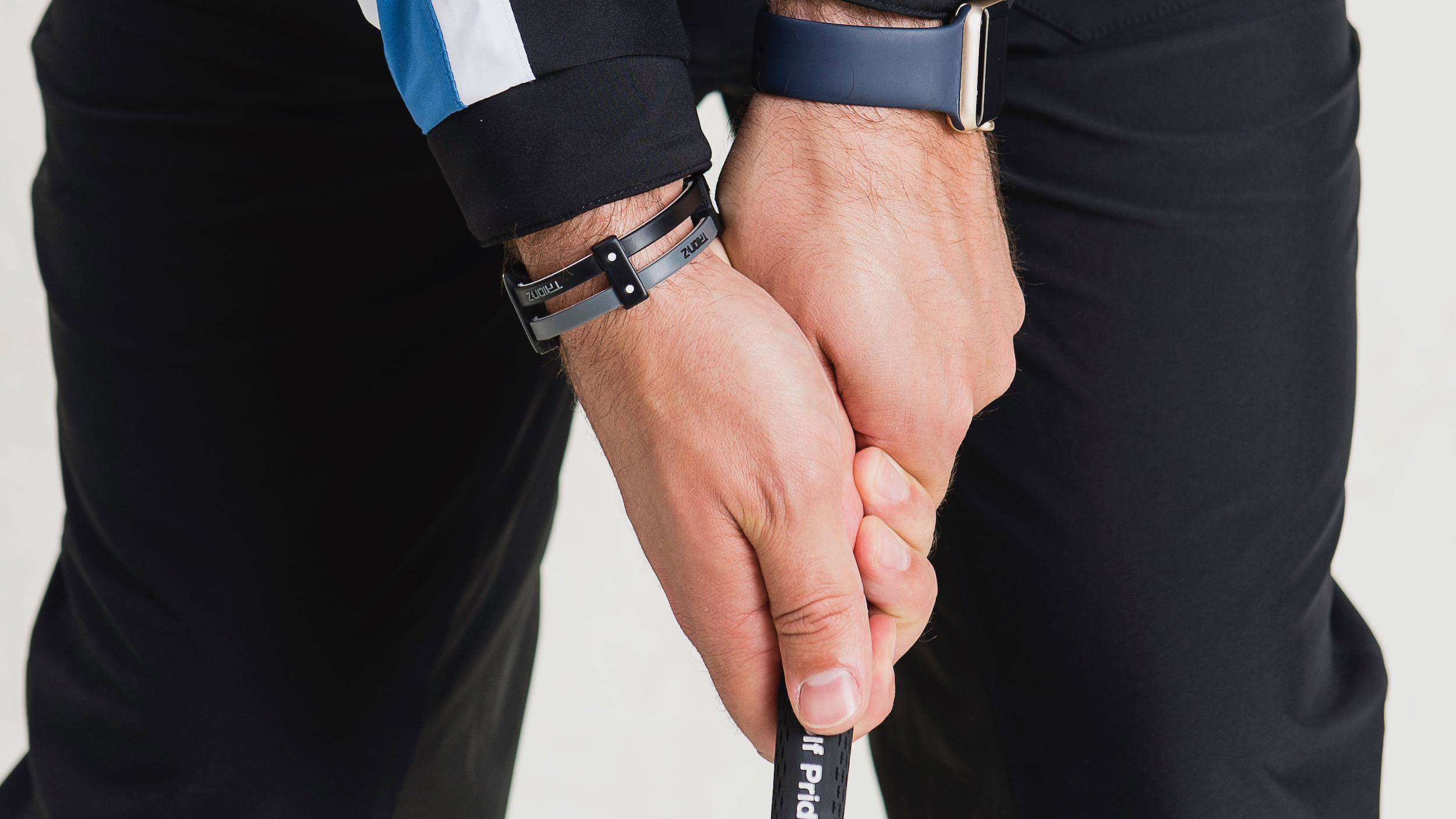
How the hands should sit in a neutral overlapping golf grip
Set-up
A good athletic posture is key to generating power - check out any tour pro’s posture and you won’t see them slouched over the ball. To get your posture correct, let your arms hang freely down from your shoulders to the ball ensuring that your shoulder blades are back rather than hunched forward.
Now, bend forward from your pelvis while maintaining your spine angle. This will also dictate how far from the ball you should stand with each club. Finally, just ‘soften’ or flex your knees a little into position.
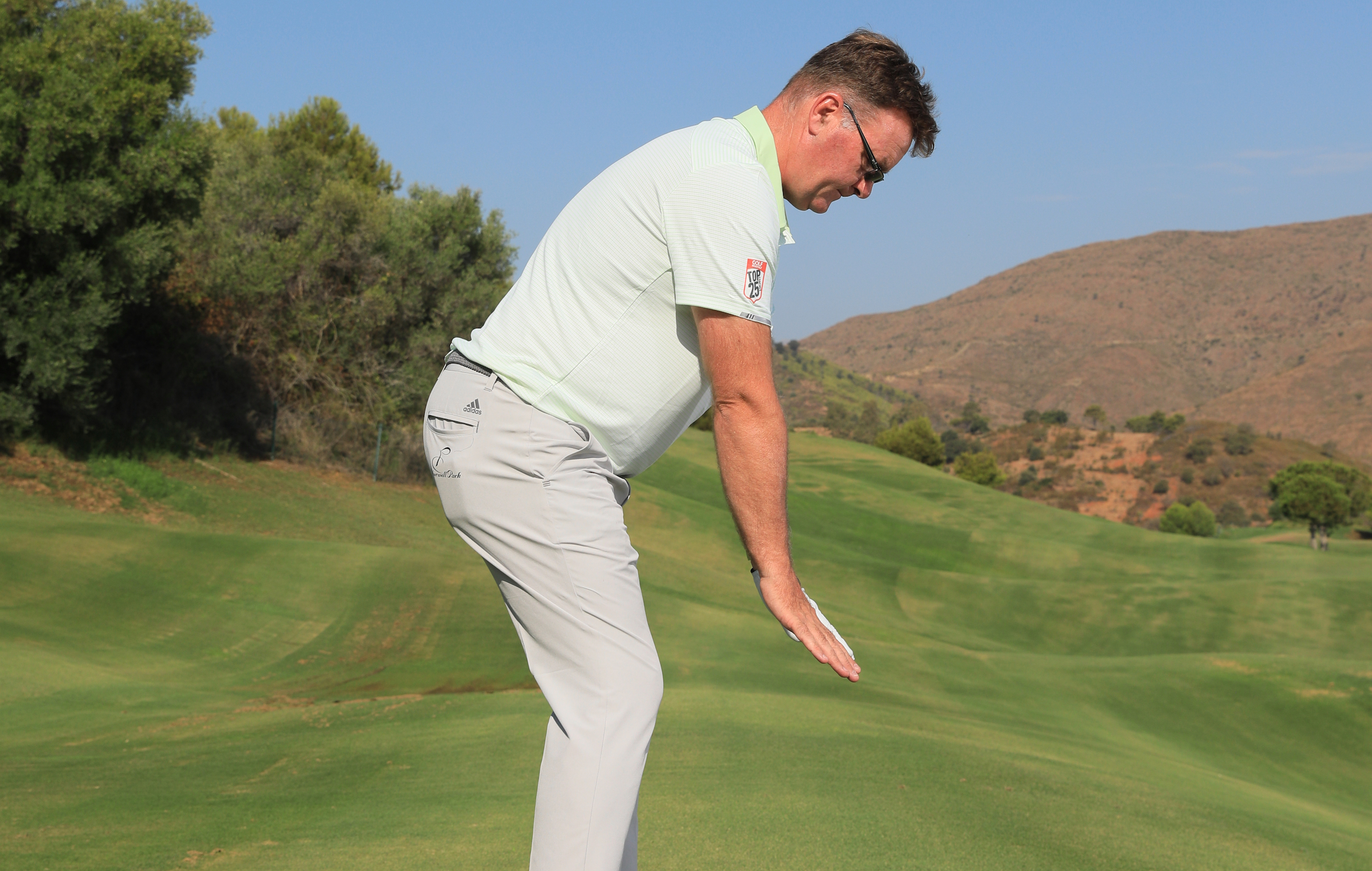
Athletic posture over the ball is important as Top Coach John Jacobs demonstrates here
Finding the perfect ball position for every club is very important - if the ball is in the wrong place as you start your swing, you are reducing your chances of good contact and the right ball flight.
But all your clubs vary in length from wedge up to driver, so how do you find the right ball position for each club?

Ball position varies from club to club, with the clubs laid out in front of Top Coach Andrew Jones indicating the ideal positions
A simple way is to start with your feet together. Then, with a short iron, take a little step left with your left foot and the same length step right with your right foot.
With a mid-iron, take the same little step left but a slightly bigger one to the right, and with a long iron the same step left again, but a slightly bigger step still to the right.
This will set your sternum in the right position to help each and every iron bottom out correctly through impact.
The only variation is with the driver as you need to hit up on the ball more. So, take just a tiny step with the left foot, then a nice big one with the right, taking care not to go too wide as this will reduce your ability to turn effectively.
If you can get the right ball position and as long as you know how to aim in golf, you'll be in a much better position to make an effective golf swing.
Takeaway
A smooth, fluid tempo in the initial movement away from the ball is critical. Any short, snatchy movement will really throw the sequencing of your swing out. A common error is to over-rotate the hands and arms at this point, which then fans the clubface open.

This exercise will give you a feel for a good takeaway. The grip should stay connected to your side to this point
A good exercise is to grip halfway down your driver with the shaft touching your left hip at address. In a good takeaway you will retain that shaft/hip connection for the first 18 inches or so. If you over-rotate your hands and arms, the shaft will separate from the hip.
Another good takeaway tip is to pop a tee-peg in the back of your glove, which should point pretty much towards the target at address. In the early part of a good takeaway, the tee should point more or less at the ball.
Again, any over-rotation of hands and arms will see the tee pointing more towards the sky, meaning your clubface is very open and will be difficult to return to square at impact.
Backswing
Good rotation of the upper body is the backswing key to storing up power. But while a good shoulder turn away from the ball is important, it will only generate power if the shoulders have something to turn or coil against.
This means your hips need to rotate less than your shoulders as you take the club up to the top (perhaps 45˚ versus 90˚).
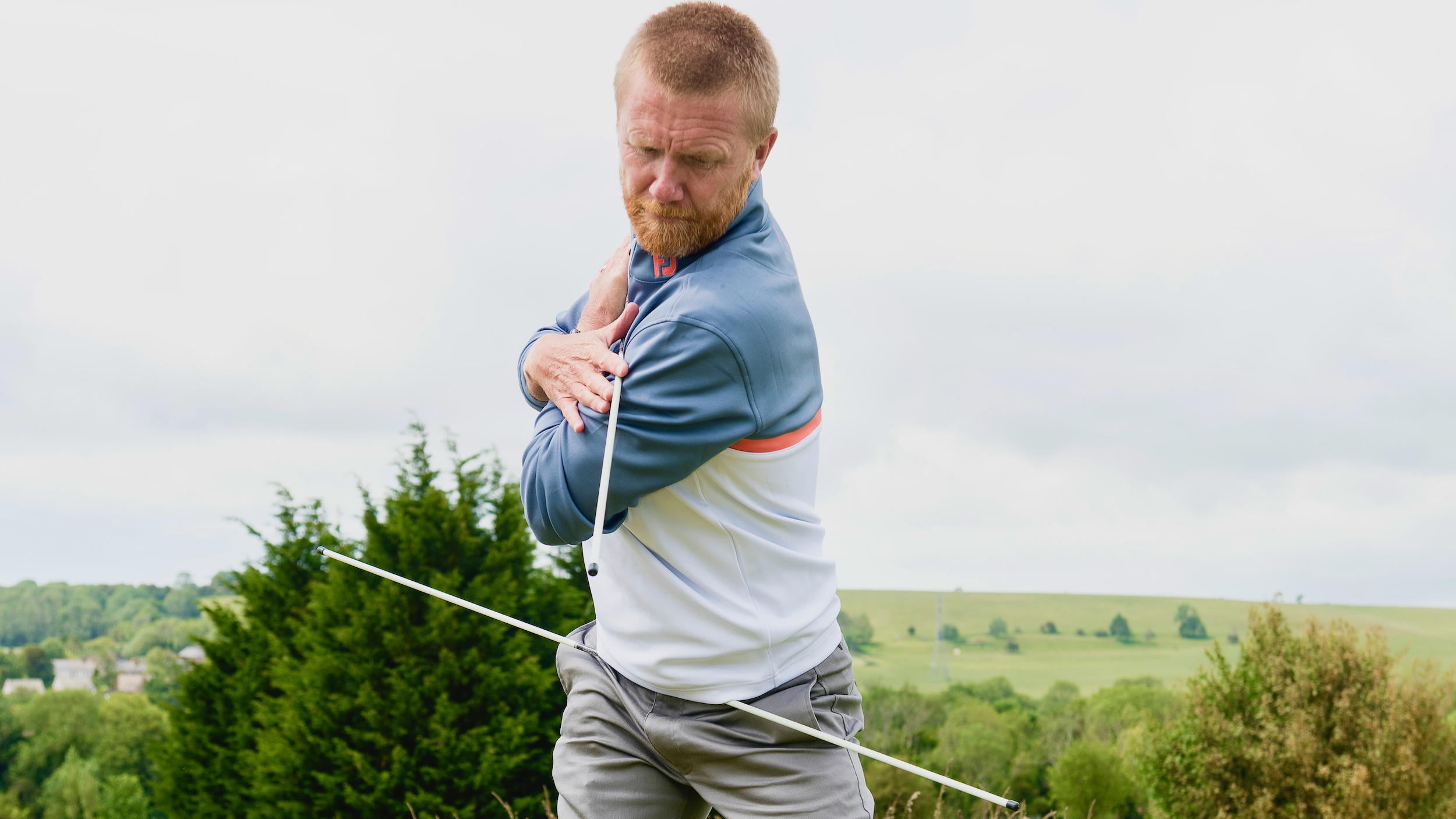
The two sticks show how coil and power are generated by the shoulders turning more than the hips
One way to work on this is to make sure you keep your right knee nicely flexed as you take the club back. If it straightens, your right hip will move backwards and you will lose power as your hips will rotate too much leaving your upper body little to coil against.
Any lateral movement will also make it much harder for you to get back to the ball consistently and generate any power, so guard against swaying rather than turning. Make sure you can feel more weight on your right leg at the top than at address.
Finally, your arms are important too. The triceps in your left arm should be nicely loaded at the top. If you let the left arm bend or collapse at the top you will lose that tension and with it the ability to store energy to release back into the ball at impact.

How the left arm should look at the top with the triceps nicely loaded
Downswing
Weight transfer is the big key in the downswing Keeping your body weight too much on your right side makes it impossible to achieve good impact. Start your downswing with a shift of your left or lead side towards the target to encourage your weight to transfer to your left side.
Try standing your golf bag by your left foot at address, then start your downswing by moving your left side towards the target, making contact with the bag through impact.
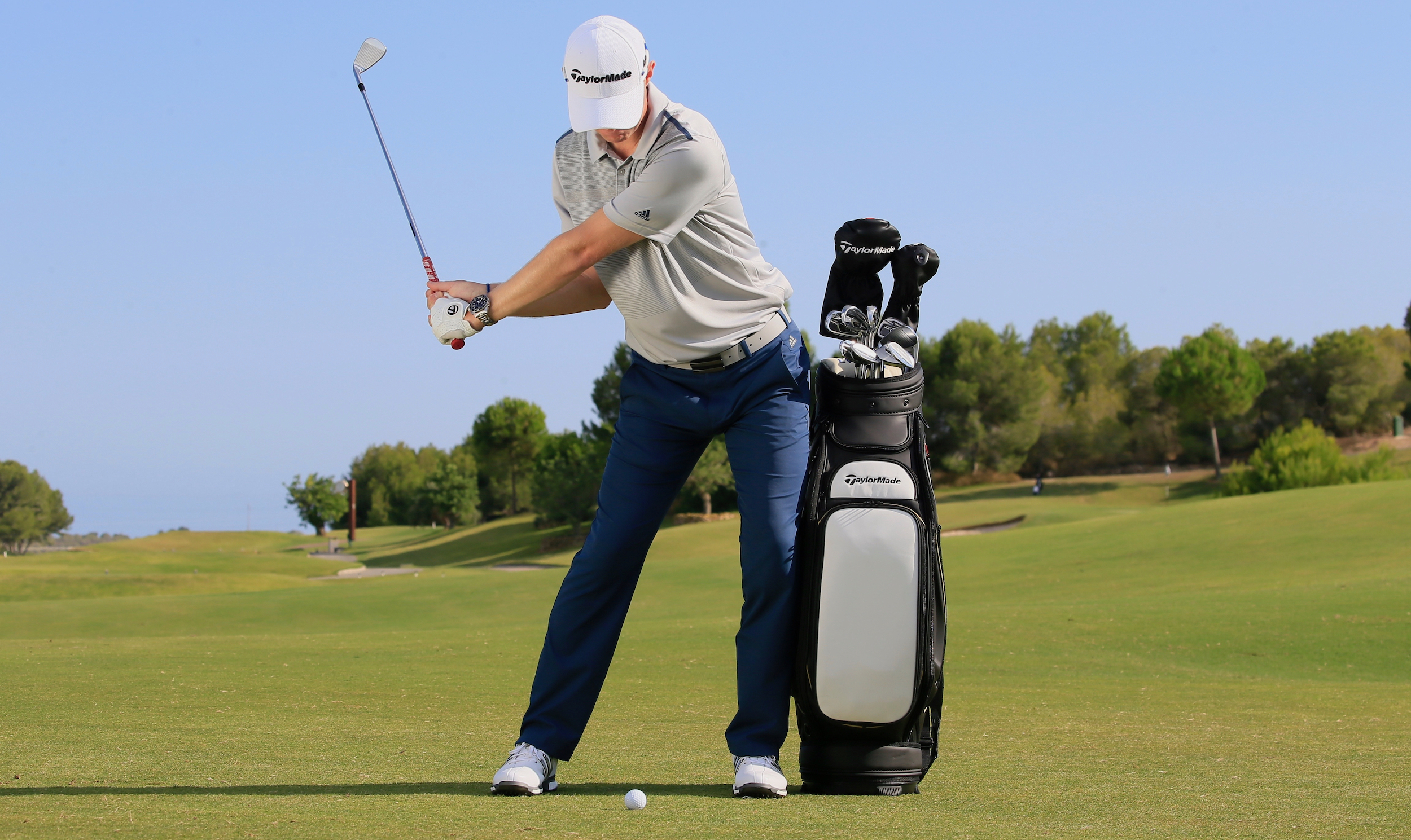
This drill from Top Coach Ged Walters will give you a feel for the correct first move on the downswing
A good thought to have is “butt of grip to lead pocket” as you swing through. Try to get the feeling of the butt of the grip pointing to your front trouser pocket on your lead leg at impact.
Impact
With an iron, you should be hitting down on the ball so the effective loft on the club at impact should be less than it would have been at address.
This simple truth is hard to grasp as golfers understandably feel the need to try and help the ball up by scooping at it with the hands or holding back on their right side in a bid to help it up. Both these will be highly counterproductive and lead to very inconsistent striking.
A good way to encourage the downward angle of attack required with an iron is to set a sheet of card or towel down a few inches behind the ball. You must then look to miss this at impact to encourage the ‘ball first, ground second’ impact required.
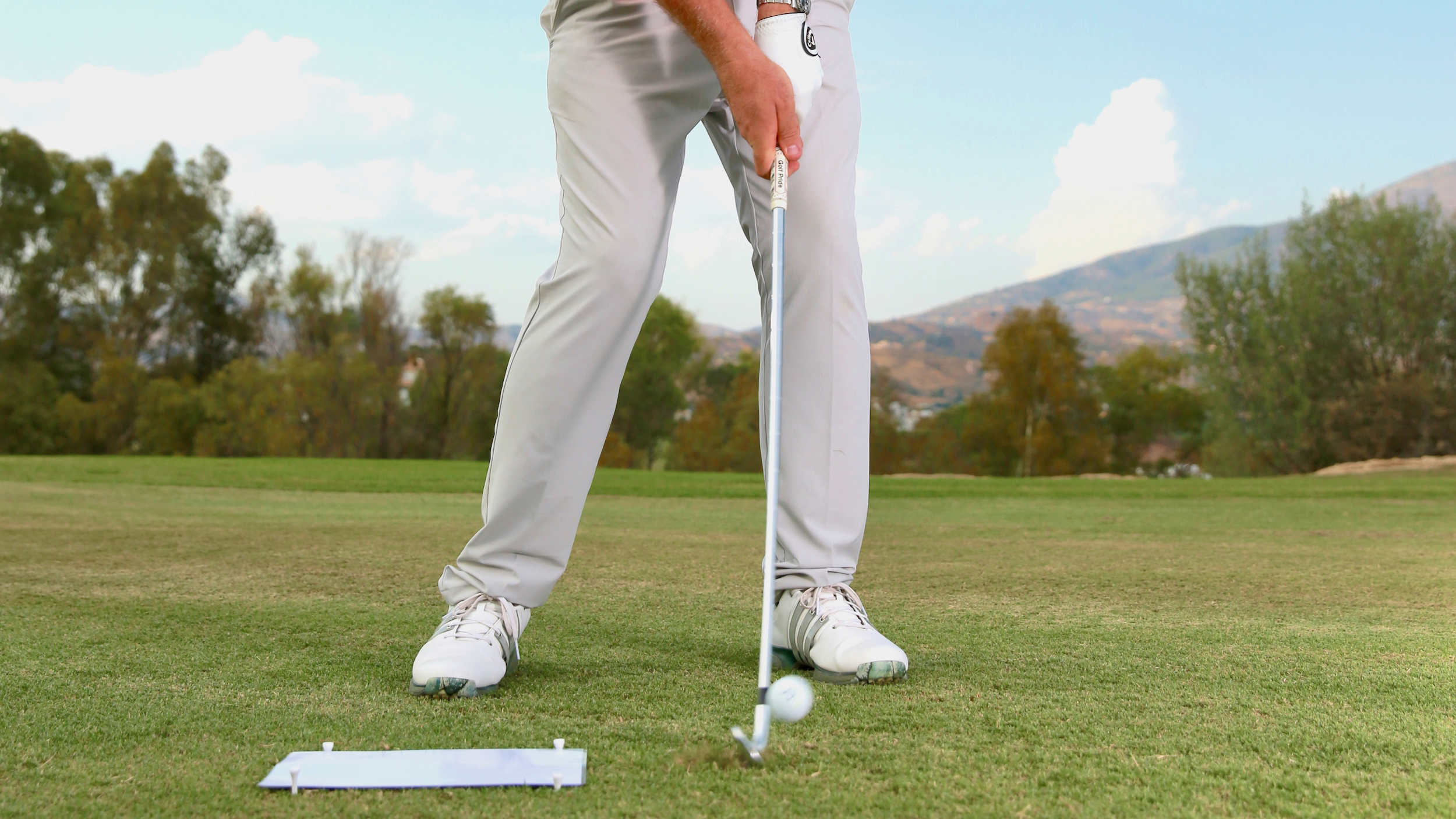
Missing the sheet of card here will encourage the downward angle of attack required with an iron
You can vary how far behind the ball you place the sheet or towel as your striking improves.
Another good way to encourage the correct weight transfer to your left side is to make the first thought at the top of your backswing to shift your right knee across towards the left.

Think about moving your right knee across towards your left knee on the downswing
Driver impact differs as you do want to hit this club on the up to optimise spin and flight. A good set-up will help you to achieve this, with the ball further forward, the stance a little wider and the spine angled away from the target more than with an iron as the right shoulder tilts down more.
Finish and follow-through
Good poise, balance and a full flowing finish can be great indicators that what has gone before has also been good. A great thing to focus on as you work through the pointers in this feature is how well-balanced you are once the ball has been dispatched.

Top Coach Peter Finch demonstrates a classic, balanced finish
Good balance will often indicate that the weight transfer required for powerful, consistent ball-striking has been good, with most of your weight transferring to the inside of your right foot going back, then on to your left as you swing through.
Poor balance as you finish could indicate poor weight transfer, which can significantly impact power and ball-striking.
If your balance is off at the end of your swing, you will know there are probably still things to work on in what preceded it!
How Hard Should I Swing The Golf Club?
A technically sound golf swing will deliver both speed and distance. However, every golfer needs to find a rhythm that allows them to deliver good speed without losing control. A good way to think about this is to rank how hard you swing the club out of 10.
If 10 is the absolute max where you are swinging so hard that you are only just able to stay on your feet and 1 sees the club barely moving - what number is your swing? Every golfer is different but with a driver, you should aim to be at around 8 on this scale. Then with your irons, that might drop to 7.
When it comes to pitching (where strike and ball flight control are absolutely essential) many top golfers like swing within themselves and their tempo would drop to about a 6.

Jeremy Ellwood has worked in the golf industry since 1993 and for Golf Monthly since 2002 when he started out as equipment editor. He is now a freelance journalist writing mainly for Golf Monthly. He is an expert on the Rules of Golf having qualified through an R&A course to become a golf referee. He is a senior panelist for Golf Monthly's Top 100 UK & Ireland Course Rankings and has played all of the Top 100 plus 91 of the Next 100, making him well-qualified when it comes to assessing and comparing our premier golf courses. He has now played 1,000 golf courses worldwide in 35 countries, from the humblest of nine-holers in the Scottish Highlands to the very grandest of international golf resorts. He reached the 1,000 mark on his 60th birthday in October 2023 on Vale do Lobo's Ocean course. Put him on a links course anywhere and he will be blissfully content.
Jezz can be contacted via Twitter - @JezzEllwoodGolf
Jeremy is currently playing...
Driver: Ping G425 LST 10.5˚ (draw setting), Mitsubishi Tensei AV Orange 55 S shaft
3 wood: Srixon ZX, EvenFlow Riptide 6.0 S 50g shaft
Hybrid: Ping G425 17˚, Mitsubishi Tensei CK Pro Orange 80 S shaft
Irons 3- to 8-iron: Ping i525, True Temper Dynamic Gold 105 R300 shafts
Irons 9-iron and PW: Honma TWorld TW747Vx, Nippon NS Pro regular shaft
Wedges: Ping Glide 4.0 50˚ and 54˚, 12˚ bounce, True Temper Dynamic Gold 105 R300 shafts
Putter: Kramski HPP 325
Ball: Any premium ball I can find in a charity shop or similar (or out on the course!)